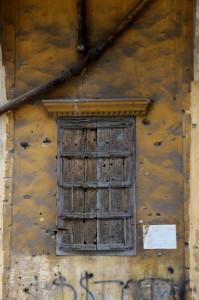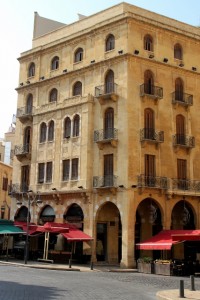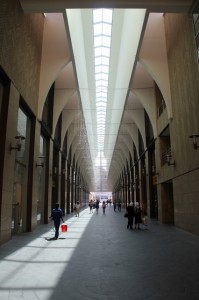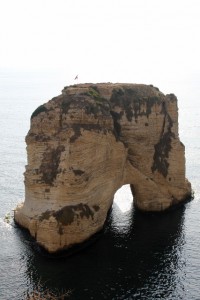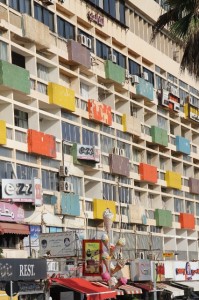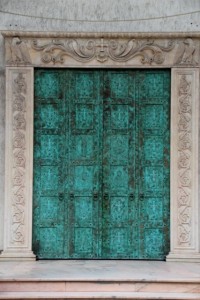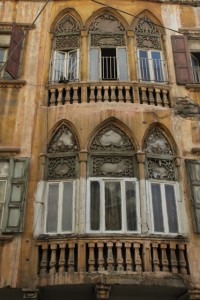A walk around the neighbourhoods of Beirut, past its cathedrals and its mosques, still shows a lot of civil war damage, but also the results of the tasteful post-war rebuilding efforts. Yet, the modern project developer is perhaps even more a threat to Beirut’s historical architecture.
“Is it safe?”, is what everybody asked us when we told them we were going to Lebanon for a couple of weeks. I suppose for current generations Lebanon will forever be associated with war. There was the bloody civil war (1975 to 1991), pitching the multiple factions of this complex country against each other through ever-varying alliances. Who hasn’t heard of the Druzes, or the Maronites, adventurous-sounding population groups who at some time or another teamed up with, or against, the Christians or the Muslims of this country, openly supported by Syrians, or by Israelis, and secretly by who-knows, who-knew-then? And after the civil war, there were the multiple incursions from Israel, violently trying to annihilate the rocket-firing Hezbollah-faction backed by Iran. Throw in hundreds of thousands of Palestinian refugees, amongst them the PLO, at least part-instigator of the conflict, and you’ll have a society as complex as they get, and that all on a piece of land one-third of The Netherlands.
Mid-September is the perfect time to visit, after the summer madness of the returning Lebanese diaspora and holidaying Arabs, and before the rains set in early October. Beirut was the scene of massive destruction during the civil war, but – although occasional traces remain visible, in the form of shot-up buildings, full of bullet holes – today it is a modern city, with a vibrant economy, judging from the construction efforts everywhere, buildings, roads, fly-overs, everything is being constructed. No sign of economic crisis here! An often-heard complaint is that the old atmosphere has been lost in the forest of concrete, and indeed, the downtown area, around the Place d’Etoile and the clock tower, has a bit of a sterile feel.
The streets have been turned into a pedestrian area, and the upmarket shops – every expensive brand has an outlet here – are not exactly teeming with people. The old Beirut souk received a make-over, as well, and has been turned into a modern shopping mall, retaining only the names, but none of the atmosphere of a real souk. It is not very busy when we visit, on a Friday afternoon, and it doesn’t seem like turnover is high. But it looks beautiful.
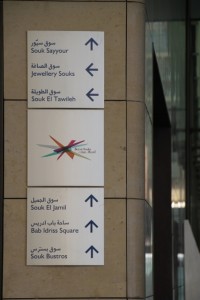
Beirut Souk: The names of the old Souk have been retained, but the streets are unrecognizable to those who shopped here before
Other areas thankfully do have a lot of character, and where I was initially somewhat put off by all the concrete, and all the construction, the longer I stayed in Beirut, the more I appreciated it. Hamra is a lively neighbourhood with a much more accessible shopping entourage, street after street, bustling with activity, and here you will find lots of people walking around, or sitting in one of the many coffee shops and cafes. Part of this quarter also caters for the many students of the American University of Beirut, or AUB as it is known locally, which is situated between the shopping area and the sea, on a fabulous campus, green, sloping down towards the beach. I don’t think they encourage tourists on the campus, but a little bluff does wonders, and we managed to get in. The contrast between the noisy streets of Hamra and the peaceful, serene, oasis-like campus is incredible. The AUB, founded in 1866, is easily the most famous university in the Middle East, and the walled compound with its yellow sandstone buildings stands out as a landmark. The Mediterranean seaside, of the AUB and well beyond, is bordered by the Corniche, a long boulevard and walking promenade sporting anglers and orange juice sellers, luxury hotels and beach clubs. And million-dollar apartments. This is where late afternoons are spent jogging, or just wandering up and down, watching others – and being seen yourself, no doubt, in one of the many bars and beach clubs. All the way at the southern end of the Corniche are the Raouche (Pigeon´s Rocks), two sandstone rocks that raise some 100 meters vertically out of the sea. Pretty place for photographs in the setting sun.
A good place to get an idea about Beirut’s past is the National Museum, a large and attractive building housing a no doubt vast collection of artefacts, of which a very small portion is exquisitely displayed: large sarcophagi and sculptures downstairs and a range of utensils and jewelry in well-lit cabinets upstairs, covering Lebanon’s history from Pre-historic time to the Middle Ages. And a history it was, from Phoenicians to Egyptians, conquering Greeks and Romans, then the advent of Muslim forces and the Crusader reaction, and finally 400 years of Ottoman occupation. The museum’s more recent history, during the civil war, is captured in a video being shown several times a day, and demonstrates how committed staff have protected the pieces by stacking concrete blocks around them – the museum itself was in the firing line, and badly damaged -, and how they uncovered everything again after the war, painstakingly cleaning the pieces, before putting them on display. How lucky we are today that some sensible people remained in Lebanon, during those insensible times.
Not far from the museum, and not far from the modern Souk, are the various religious buildings representing Lebanon’s complex mix. The huge, modern Mohammad al-Amin mosque, with its blue roof and multiple tall minarets, stands out, whilst the smaller, older, Grand Omari mosque is somewhat hidden in one of the streets leading away from the Place d’Etoile. The mosque is built in a Crusader church, clearly visible from the interior with high vaulted bays. The old Maronite cathedral of Saint George is being fixed, whilst the Orthodox cathedral, also of Saint George, is on the other side of the block, with a small museum of underground galleries, once again demonstrating the several historical periods Beirut went through, including Roman mosaics and well endowed Mameluk graves. Just to the east is the Place des Martyrs, so-called because of the public execution of independence activists at this square in the dying days of Ottoman occupation, with a restored but still bullet-riddled sculpture.
A little further, Rue Monot used to be the main nightlife district, a narrow street where parking is impossible – which doesn’t deter the Beiruties from trying. But this is rapidly being replaced by nearby Gemmanzeh, a neighbourhood with well over 200 bars and nightclubs. Cocktails and life music is the minimum expectation. In the late afternoon, on the terrace of Café Paul, a trendy café-bar, coffee will do, accompanied by Amy Whinehouse from the bar’s music system, competing with the Alluh Akbar from the great mosque.
Above Gemmenzeh, climbing the stairs of St Nicholas is the neighbourhood Archefeye, with a number of old houses in reasonable state of repair. The most impressive one is the Sursock house and museum, built by the Sursock family, an old Beiruti dynasty. Sadly, recently the property has been divided between different family members, the one who got the house cares about the inheritance, and does everything to maintain the fabulous building, whilst another, who got the beautiful garden in front of the house, didn’t care so much, and sold out to a developer who is now building an underground parking garage for a neighbouring apartment building. The museum is thus now closed, and the area in front is a mess. This doesn’t bode well for preservation in Beirut. And indeed, it is increasingly difficult to find old buildings; some exist across town, perhaps 100 years old, balconies, nicely shaped tall windows, sometimes even with stained glass, wooden shutters.
But many that survived the war don’t survive the project developer. It is often much more profitable to pull down an old, 4-5 story building in need of expensive repairs, and build a 15 floor apartment building instead, at the expense of the cultural heritage. It is thus good to see that the occasional inhabitants hold out, and insist on their view from their window, which forced at least one developer to start building a neighbouring block only from the 3rd floor upwards!! But mostly, especially towards the suburbs, Beirut consists of concrete apartment block, 50’s style, or 70’s style, or more recent: the quintessential modern Lebanese way of living. Of varying heights, all of these buildings have plenty balconies, many of those covered with heavy curtains, to keep out the sun, and perhaps prying eyes from the neighbours. Some of the newer buildings have the balconies glassed-in, to create an extra room, but mostly, the curtains, sometimes pushed forward to allow for the laundry, dominate in various earthy colours, plain or striped. And this style continues well beyond the city limits. All the way up the mountain slopes it seems Beiruties, even the richer ones, don’t want freestanding houses, villas with gardens, but prefer a multi-story apartment block.

Typical Beirut apartments, balconies covered with heavy curtains to keep the heat, and prying eyes, out.
No account of a big city is complete without commenting on the traffic, and that is especially so for Beirut. Traffic is a madhouse, with cars pushing their way through the tiniest of openings – the rule is to get your bumper there before the other car; once you done this the other has to back off (or try a crazy move avoiding your bumper by swerving around, accelerating, and then trying to push in front, further ahead). It is important to drive fast, but even more important – macho behavior – to do this with one hand only, and with the other preferably holding a mobile phone to your head. It doesn’t help that the main roads are being reconstructed, which means that there are, for starters, no markings on many of the roads, leaving everybody to interpret freely where the middle is, critical in overtaking. Obviously, traffic from the opposite direction also over-estimate their middle line in a similar overtaking movement. Further chaos is created when roads, often designated motorways, are being narrowed from three to one lane, suddenly, due to work in progress (you seldom see much actual work in progress, but never mind). A three lane road in Beirut normally contains five rows of cars, in any case. All of this is not helped by the average attitude towards driving from the average driver. Unlike many other cities, Beirut only deals with cars, here there are no bicycles, only very few motorbikes, and pedestrians cross at their own peril, so preferably not. Cars come in all sizes and from all ages, varying from the newest SUVs and the most expensive Jaguars and Audis, to the equivalent of Cuba’s 1960’s American cars, but then of European stock. Especially BMWs and Mercedes must have been popular early on, and many an old model can be seen, mostly battered from years of traffic participation, but still in working order. Oh, and another one, you need to know which traffic lights can be ignored whilst others cannot, but some not at all times – very complex indeed!
The only thing that commands respect in traffic, is – funny enough – the army and the police, whenever they wish to enter a traffic stream, everybody rolls over each other to let them in, make way. At control points they are treated with the same respect, no Lebanese would ever dream of driving on without having received the almost imperceptible nod, or slight movement of the hand, indicating that they can go. And road blocks are everywhere, in Beirut and outside. Yet, nobody seems to be bothered by this omnipresence of the law. Or by the omnipresence of armed soldiers, in and around Beirut. In fact, nobody seems to be bothered by much at all, Beiruties live their lives from day-to-day, possibly realizing that you can’t tell what comes tomorrow anyhow, so you might as well enjoy today. And Beirut is definitely the place to do that.
Continue: The History of the Harbours


